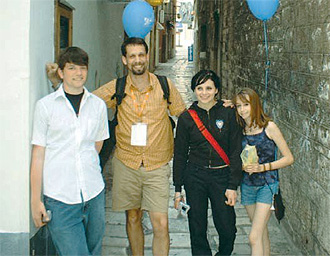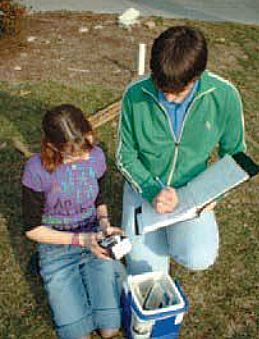|  |  | |  |

|  |  |  |  |  | The Globe Program: Science in the Sunshine
|
12.18.03
|
Who are NASA's Earth Explorers?
The elementary school student wondering how El Niño will affect tomorrow's weather. The scientist studying connections between ozone and climate change. And the farmer using satellite pictures to keep track of crops. All of these people are Earth Explorers -- they are all curious about the Earth system. This monthly series will introduce you to NASA Earth Explorers, young and old, with many backgrounds and interests.
|

|
(From left to right) Chris Hanawalt, Frank Niepold, Melanie Benetato and Gianna D'Emilio travel to Croatia to present their findings at an international GLOBE conference. Photograph by Frank Niepold |
It was the perfect idea for a science fair project, and Gianna D'Emilio had no trouble convincing several of her friends at the Edmund Burke School in Washington, DC, to help. Basically, they agreed to go out on the lawn and take air quality readings. They would go out every sunny day at a time when NASA's Terra satellite passed over the area to assess the amount of sunlight reaching the ground.
The commitment paid off when the group was one of 12 teams selected to present their findings at the 2003 GLOBE Learning Expedition held in July in Sibenik, Croatia. There, along with students and teachers from 22 countries, they presented their projects and discussed ways everyone could work together to collect more data for environmental research.
GLOBE is an international organization of students and teachers who collect and share data about the health of the environment. In the United States, GLOBE is sponsored by several scientific and government agencies, including NASA, the National Science Foundation, the Environmental Protection Agency, and the State Department.

|
D'Emilio and Hanawalt take aerosol measurements using a hand-held sun photometer. Photography by Charles Kellett |
D'Emilio's initial idea was to find out how pollution affects the color of the sky. Her science teacher, Frank Niepold, suggested that she begin by studying how aerosols -- tiny airborne particles from a variety of natural and human-generated sources -- affect not only sky color but also weather and climate.
When David Brooks, a GLOBE scientist at Drexel University in Philadelphia, heard about the project, he suggested another idea to D'Emilio and her team: How about validating aerosol measurements taken by a NASA satellite? While the satellite measured from the sky downward, simultaneous measurements made from the ground up would add value and meaning to the data.
Brooks heads the GLOBE Aerosol Monitoring Project, which has developed an instrument called a sun photometer and some protocols, or standard operating procedures, for its use in collecting aerosol data. D'Emilio's team, including fellow student Jordan Glist and two recent Burke School graduates, Chris Hanawalt and Melanie Benatato, met first to take the daily readings, and later to analyze the data and write a report.
Their data showed that although the aerosol-measuring instruments on the Terra satellite were able to make accurate readings over homogeneous surfaces like oceans, they were less successful in making readings over variable terrain like urban areas. The team sees one of their greatest accomplishments as successfully testing the instrument.
Another Burke team is being formed to continue the project when NASA's Aura satellite launches in 2004. With instruments onboard designed to measure the vertical profile of aerosols using different wavelengths of light, Aura will add new and valuable data about global aerosol distribution.
In the future, Burke students hope to enlist the help of other GLOBE students that attended the conference. In fact, a school in Bremen, Germany, is planning to take similar data this summer, and several other GLOBE participants are also exploring partnership opportunities.
Related Resources
GLOBE
http://www.globe.gov
Terra
http://terra.nasa.gov
Aura
http://aura.gsfc.nasa.gov
S'COOL
http://scool.larc.nasa.gov
Adapted with permission: ChemMatters magazine © American Chemical Society 2003
http://www.chemistry.org/education/chemmatters.html
|
|  |
|
